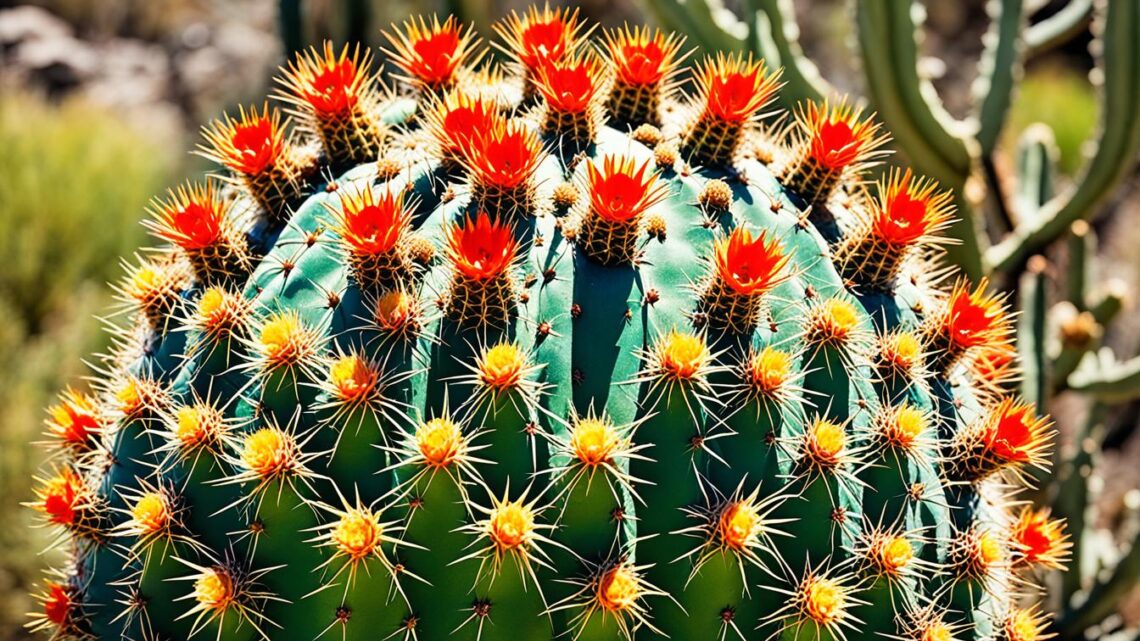
Ever wondered why cacti, symbols of the American Southwest, bloom? The reasons might surprise you. These flowers are a marvel of nature, with their short but beautiful lives. What makes a cactus decide it’s time to bloom?
When it gets warmer, most cacti wake up and show off their flowers. Some even bloom in the winter, showing how tough they are. Light, temperature, and soil matter a lot, but cacti have special ways to bloom at the best time.
Learning about when cacti bloom helps us appreciate these desert plants more. Let’s dive into the amazing world of cactus flowers. We’ll uncover the secrets behind their beautiful blooms.
The Magic Behind the Cactus Bloom
Seeing a cactus bloom is rare and amazing. It’s a big moment in the plant’s life. The cactus looks tough, but its flowers are soft and colorful. This change shows how beautiful cactus flowers are, loved by many for years.
Unraveling the Allure of Cactus Flowers
Cactus flowers are known for their short beauty. They bloom for just a day or night. This makes each bloom special and rare.
Their colors and patterns are amazing. They go from soft pastels to bright colors. This shows how nature is full of beauty.
It takes years for cactus flowers to grow. This makes each bloom even more special. It’s a rare sight to see.
A Milestone in the Cactus Life Cycle
The cactus bloom is a big deal in its life. It changes from tough to delicate and fragrant. This shows how strong and flexible the cactus is.
It blooms in harsh places, using little resources for its flowers. This shows how it can thrive despite challenges.
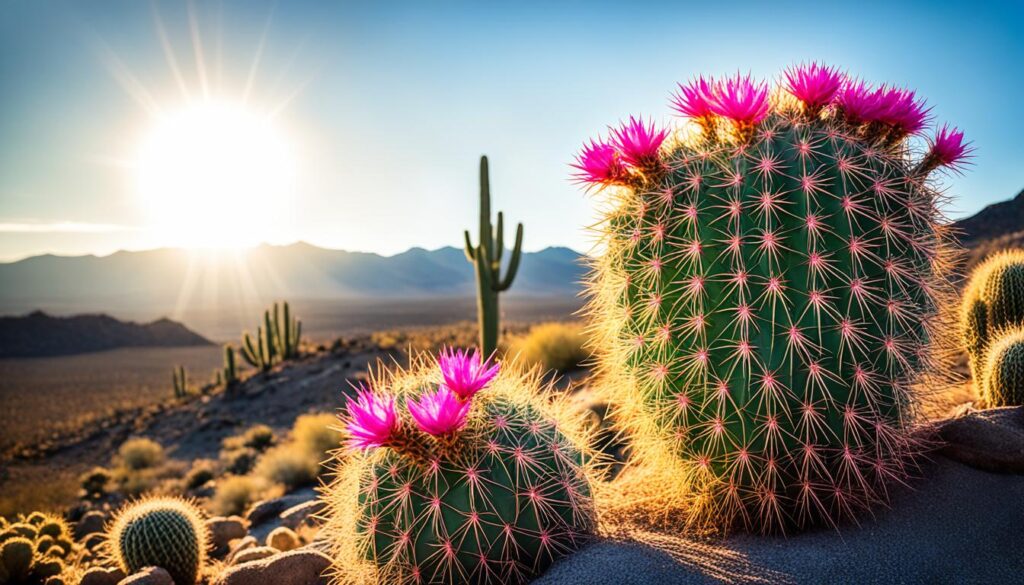
The cactus bloom is magical. It inspires and amazes people. It’s important in culture and symbolizes strength and resilience.
It has a special spot in the hearts of those who love plants and nature. Learning about these plants shows why each bloom is so enchanting.
When Do Cacti Start Showing Off?
Cacti bloom in a special way, not just anytime. They bloom when they are old enough and have grown enough. Their blooms often come with the seasons.
Understanding Blooming Readiness
Cacti need to be a certain age before they bloom. Young cacti may wait until they grow bigger. Knowing when they are ready to bloom is key to seeing their flowers.
Seasonal Influences on Flowering
The seasons affect when cacti bloom. Most cacti bloom in the warm months, from spring to late summer. But, some cacti bloom in the winter too, showing how tough they are.
In places like San Diego, the warm and dry weather is perfect for cacti. This makes many cacti bloom in the spring and summer. Some cacti even bloom more than once in a season.
Some cacti that bloom during these months include Notocactus magnificus and Echinopsis «Dominos». Others are Eriosyce/Neoporteria senilis and Ferocactus macrodiscus. Echinocereus reichenbachii, Copiapoa esmeraldiana, and Astrophytum capricorne also bloom then.
Notocactus buiningii, Melocactus concinnus, and Sulcorebutia mentosa also bloom during this time. Gymnocalycium pflanzii and Notocactus uebelmannianus join in too.
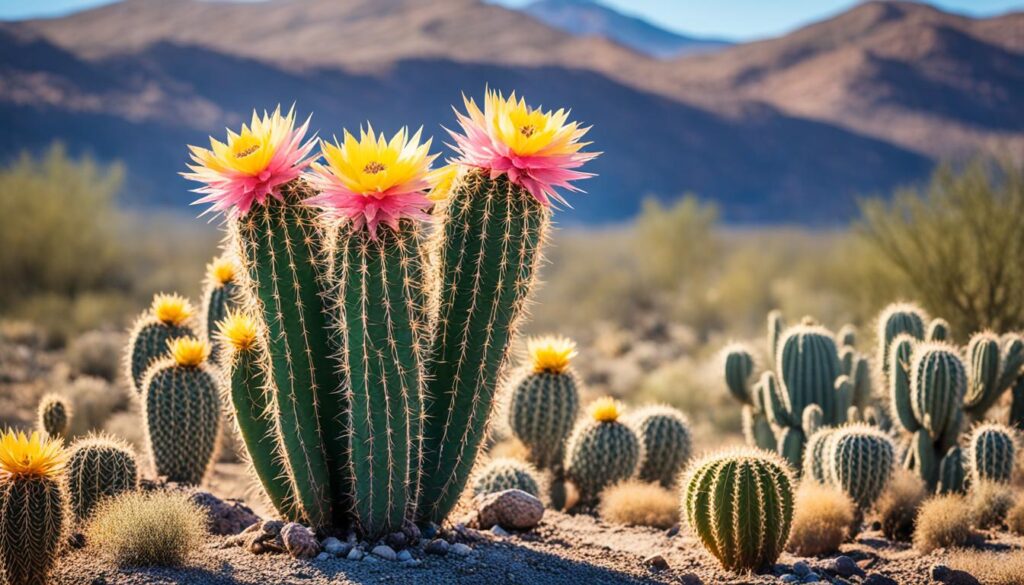
Some cacti bloom just once, but others show off for days. Their flowers attract bees and help their environment.
Setting the Stage for Cactus Flowers
To make your cactus bloom well, you need the right conditions. Learn about lighting, temperature, water, and food for beautiful flowers.
Mastering the Art of Lighting and Temperature
Cacti love bright sunlight. Place your cactus in direct sunlight for a full day, near a south-facing window. If sunlight is hard to get, grow lights can help.
The best temperature for cactus flowers is 25°F to 90°F. This matches their desert home.
Balancing Hydration and Nourishment
- Watering: Wait until the top inch of soil is dry before watering again. This stops root rot and keeps the plant strong.
- Fertilizing: Feed your cactus in spring and summer with a balanced fertilizer like 10-30-20. This helps flowers grow.
- Pruning: Cut your cactus in early spring to help it focus on flowering. Cut just above a leaf node to get new growth.
With the right balance of light, temperature, water, and food, your cactus will bloom beautifully.
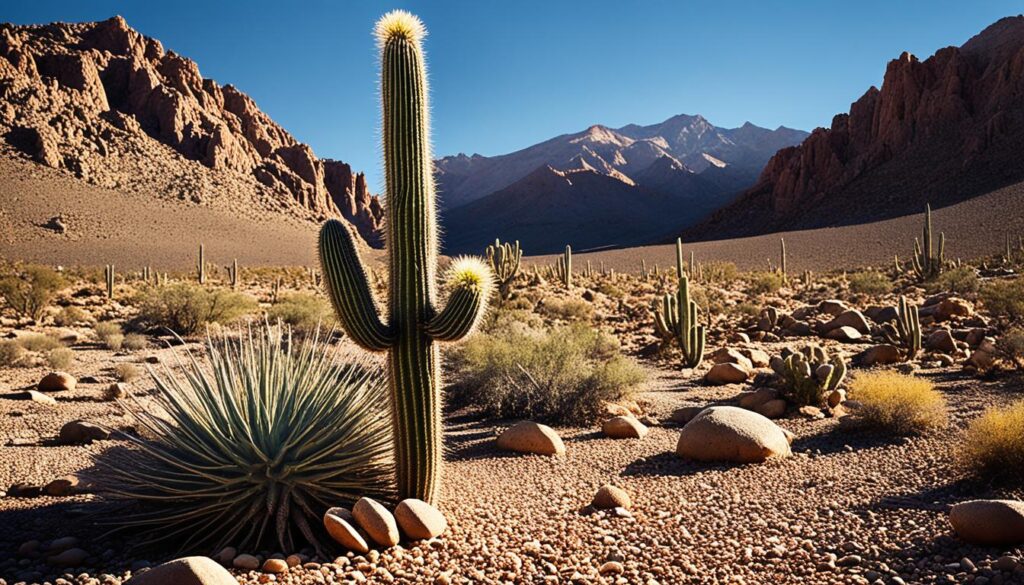
when a cactus flowers
Cacti have a special way of blooming that changes with each type. Some may wait up to 50 to 100 years to show their flowers. Others bloom every year, showing off their bright flowers.
Many things affect when a cactus flowers, like how old the plant is, the weather, and the season. Most cacti bloom in the warm months, from late spring to late summer. A few surprise with flowers in winter.
For cacti grown indoors, they need a cold period in winter to flower. They need at least six hours of sunlight a day. If they don’t get enough sunlight, you can use special lights for them.
Using a special kind of fertilizer can help cacti flower more. Also, not watering them much in winter helps them bloom better.
| Cactus Flowering Facts | Details |
|---|---|
| Bloom Duration | Some cactus flowers last only a few hours, while others may bloom for a couple of days. |
| Bloom Timing | Cacti can flower in late spring, summer, or even winter, depending on the species and maturity level. |
| Bloom Colors | Cactus flowers come in a wide array of vibrant colors, including red, pink, orange, yellow, white, and bi-color combinations. |
| Night-Blooming Cacti | A significant number of cactus flowers bloom at night to attract nocturnal pollinators. |
If you love cacti or are just starting to learn about them, knowing when they flower is fascinating. It shows how special and diverse these plants are.
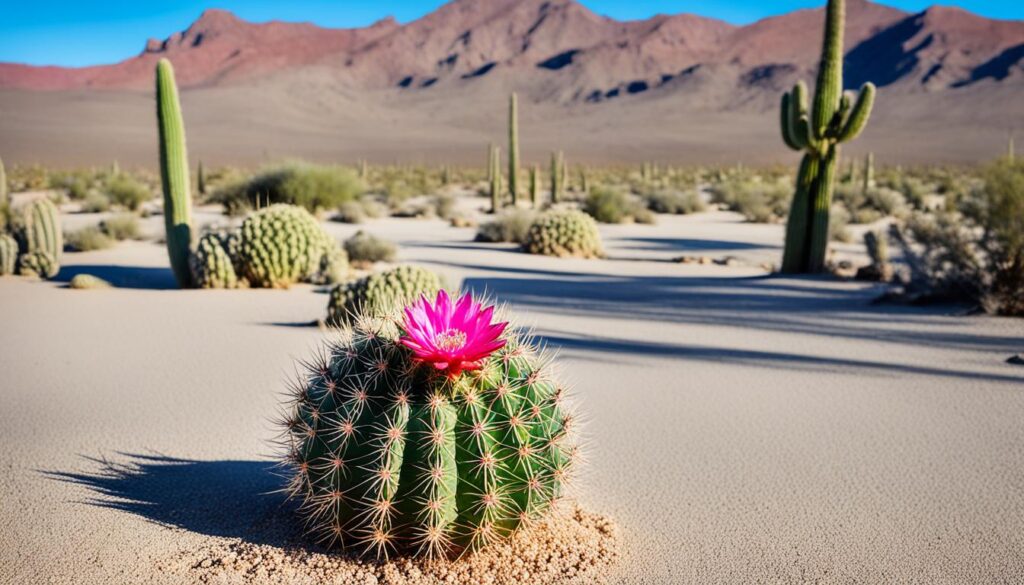
Tricks to Trigger Cactus Blooms
You can’t make a cactus bloom, but you can try to help. Techniques like repotting or changing the root space might make them bloom. But, be careful not to harm the plant while doing this.
Stress as a Catalyst for Flowering
A little stress can help cactus blooms. Cacti grow in tough desert places. They get used to drought and big temperature changes. By giving them a bit of stress, you can make them bloom.
- Temperature changes: A slight chill in the fall can make flower buds grow.
- Water stress: Cutting back on water as blooms come can make them grow better.
- Nutrient stress: A potassium-rich fertilizer in the growing season helps blooms grow.
Repotting and Root Space Adjustments
Repotting can help cacti bloom. When a cactus gets too big in its pot, it might start making flowers. But, make sure to repot at the right time and give it enough room for roots.
- Repot in the spring when the cactus is growing well to reduce stress.
- Choose a pot that’s just a bit bigger than the old one to keep roots in check.
- Use a soil mix made just for cacti to help them grow and bloom well.
Understanding how stress and care work together can help you make cacti bloom. This way, you can enjoy their beautiful flowers.
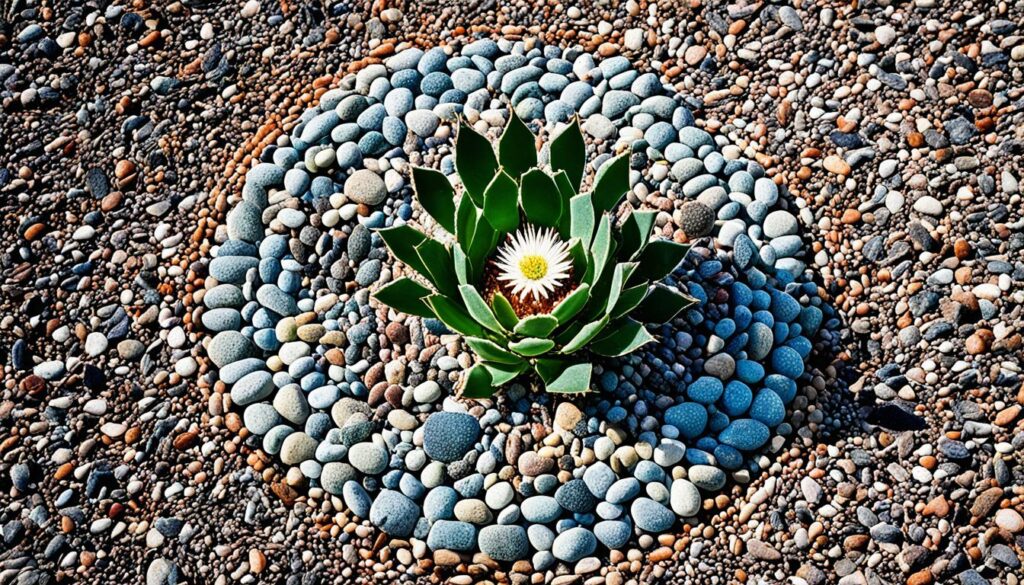
Spotting the Signs of Upcoming Blooms
Watching cactus flowers bloom is a joy. Early signs of their bloom can be exciting. Savvy gardeners look for these signs.
One clear sign is the flower buds. These small buds grow at the plant’s base. They get bigger as they get ready to bloom.
You might also see the cactus change shape or color. It might get taller or turn a new color. This means it’s getting ready to bloom.
| Sign of Cactus Blooming | Description |
|---|---|
| Flower Bud Appearance | Tiny protuberances at the base of the plant’s spines that gradually enlarge over time |
| Changes in Plant Shape and Color | Subtle increases in height and noticeable shifts in hue as the cactus prepares to bloom |
By watching for these signs, gardeners can know when their cactus will bloom. This lets them enjoy the beauty that’s coming.
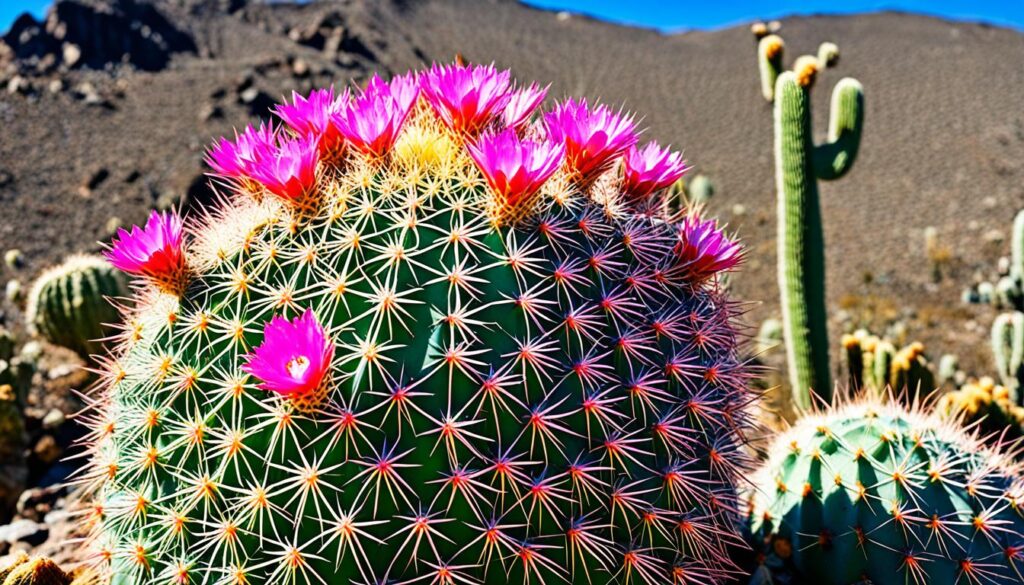
Blooming Periods: A Seasonal Spectacle
Cactus flowers bloom in two main ways: day and night. Day-blooming cacti open their flowers in the day. They attract bees, butterflies, and birds. Night-blooming cacti bloom at night. They attract moths and bats.
Day-Blooming versus Night-Blooming Cacti
In the Sonoran and Mohave deserts, cactus flowers bloom at different times. From late February to mid-April, annuals bloom in the winter. In March, herbaceous perennials and small shrubs also bloom.
Spring brings cacti into bloom, with many species showing up in April. Summer annuals start flowering after the first summer rain. These include summer poppy and devil’s claw.
Trailing four-o’clock and desert marigold bloom after rain, not just in spring. The pincushion cactus blooms five days after summer rains start.
Some cacti, like the whitethorn acacia and velvet mesquite, bloom in spring and summer. The desert willow blooms from spring to fall with enough water. The Balloon Cacti bloom in summer, usually after being four to six years old.
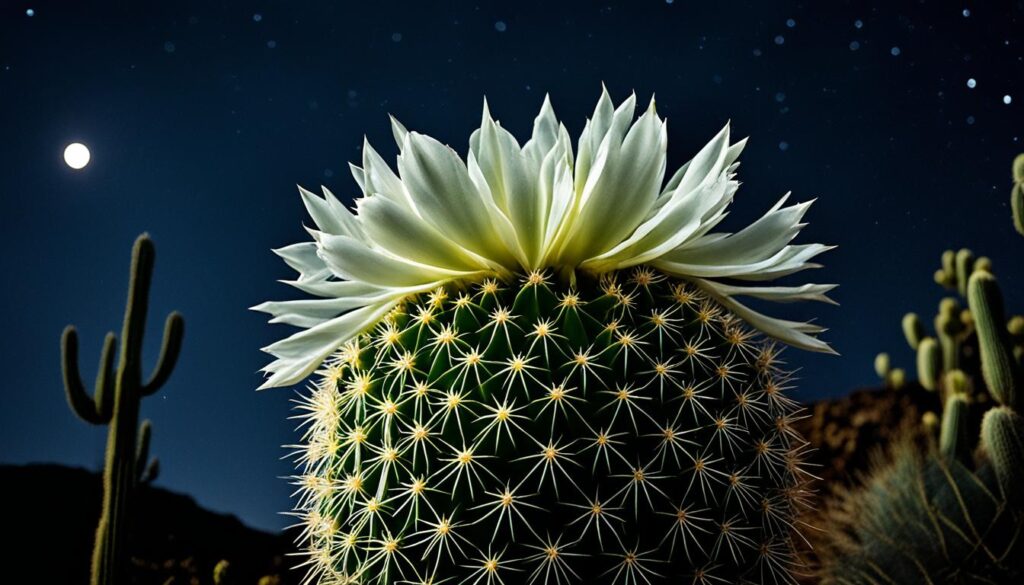
Factors Influencing Cactus Flowering
Many things affect cactus flowers. Important ones include light and sun exposure, watering practices and soil conditions, and temperature and climate considerations. Each one plays a big part in how well cacti bloom.
Light and Sun Exposure
Cacti love lots of sunlight. This sunlight helps them bloom. Make sure your cactus gets enough sun exposure to bloom well.
Watering Practices and Soil Conditions
Getting the watering and soil right is key for cactus flowers. Too much water can cause root rot and stop blooming. Too little water can stress the plant and stop it from flowering. Sandy soil that’s well-draining is best for cacti.
Temperature and Climate Considerations
The temperature and climate affect cactus blooms. Sudden changes can mess up the plant’s cycle. Know what temperature your cactus likes and keep it stable for best blooms.
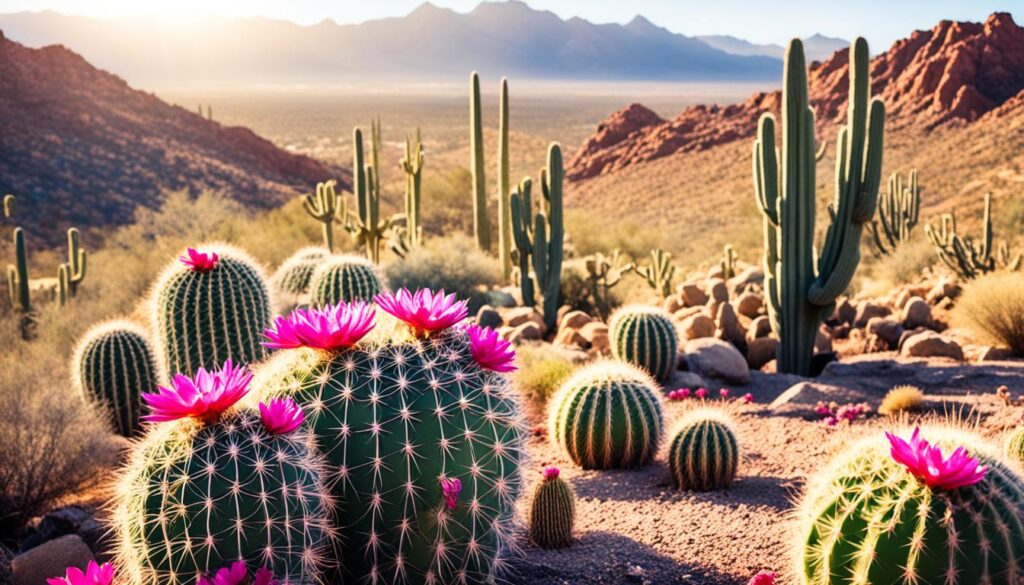
Think about light, water, soil, temperature, and climate to help your cactus bloom well. With the right care, you can enjoy beautiful cactus flowers.
The Allure of Night-Blooming Cacti
Night-blooming cacti, like the Epiphyllum (also known as the orchid cactus), are very special. They sleep all day and wake up at night to show off their big, sweet-smelling flowers. The Epiphyllum, often called the «Queen of the Night,» is a sight to see for garden lovers.
Epiphyllum: The Queen of the Night
The Epiphyllum, or orchid cactus, shows the magic of night-blooming cacti. These plants can grow up to 10 feet tall and have beautiful white, pink, or yellow flowers. These flowers only open for one night. The Epiphyllum has inspired stories, songs, art, and even a perfume, touching the hearts of people around the world.
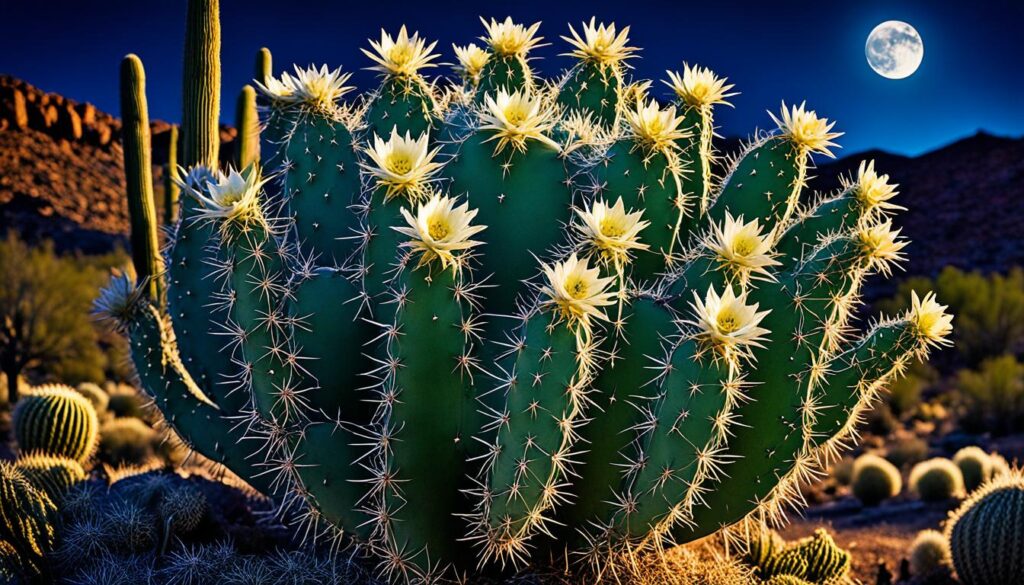
The Night-Blooming Cereus (Peniocereus greggi), also known as «The Queen of the Night,» blooms for just one night a year. This makes its short time in the spotlight even more special. Photographers love to capture the beauty of these flowers, showing how short-lived yet beautiful they are.
Night gardens are perfect for enjoying under the moonlight. They feature plants like the Epiphyllum and Peniocereus greggi that smell great at night. These plants make any outdoor area magical, creating a peaceful place for enjoying the night.
Cactus Bloom Myths Debunked
Many people think all cacti bloom, but that’s not true. Not every cactus can make flowers. It depends on the type of cactus.
Some cacti can bloom, while others don’t. This is because it’s in their nature.
Some think cacti only bloom outside. But, many can bloom inside too, if the conditions are right. How often they bloom can change with the type of cactus and its environment.
- Not all cacti are destined to produce flowers – the blooming ability is species-dependent.
- Cacti can bloom indoors if provided with the appropriate growing conditions.
- The frequency of cactus blooming differs across species and is influenced by environmental factors.
Learning about cactus bloom myths and cactus flowering misconceptions helps us see how amazing these plants are. With the right care, you can see a cactus bloom in your home or in nature.
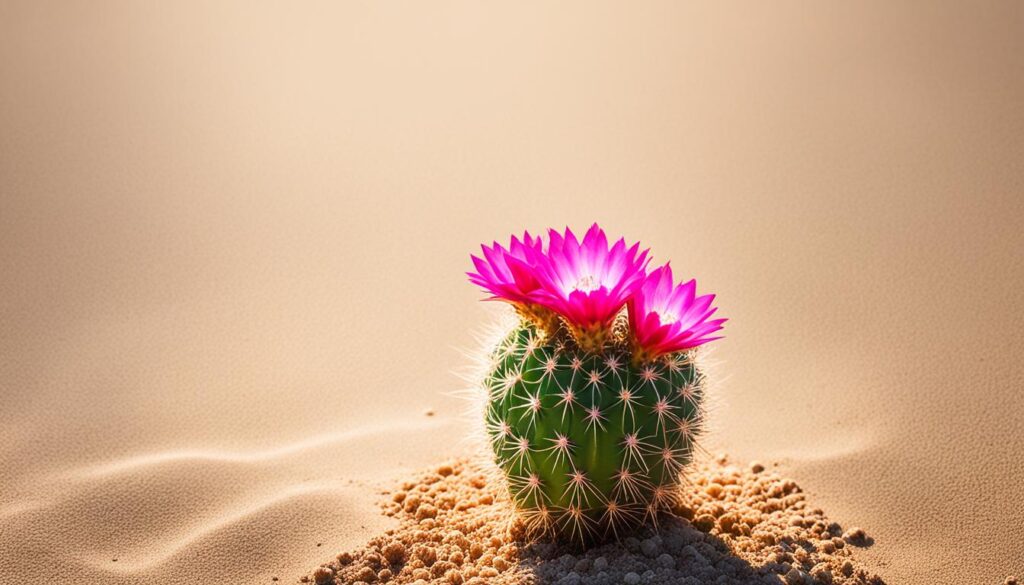
The Ephemeral Beauty of Cactus Flowers
Cactus flowers show off their beauty for just a short time, often for only a day or two. This short life is a key part of how cacti survive in tough places. The cactus flower ephemeral beauty shows how tough and smart these plants are.
Adaptation to Harsh Environments
Cacti live in places with very hot sun, little rain, and big temperature changes. The cactus flower adaptation helps them use their energy well. This way, they can reproduce and keep their species going.
Pollination Strategy and Energy Conservation
The way cactus flowers handle cactus pollination and energy is very smart. They bloom at night or when it’s cool, which matches when moths and bats are active. This helps them pollinate better and save water and nutrients.
For example, the Hylocereus undatus blooms for just a few hours at night. The claret cup cacti have flowers that last a bit longer, up to five days. This shows how well they manage their energy.
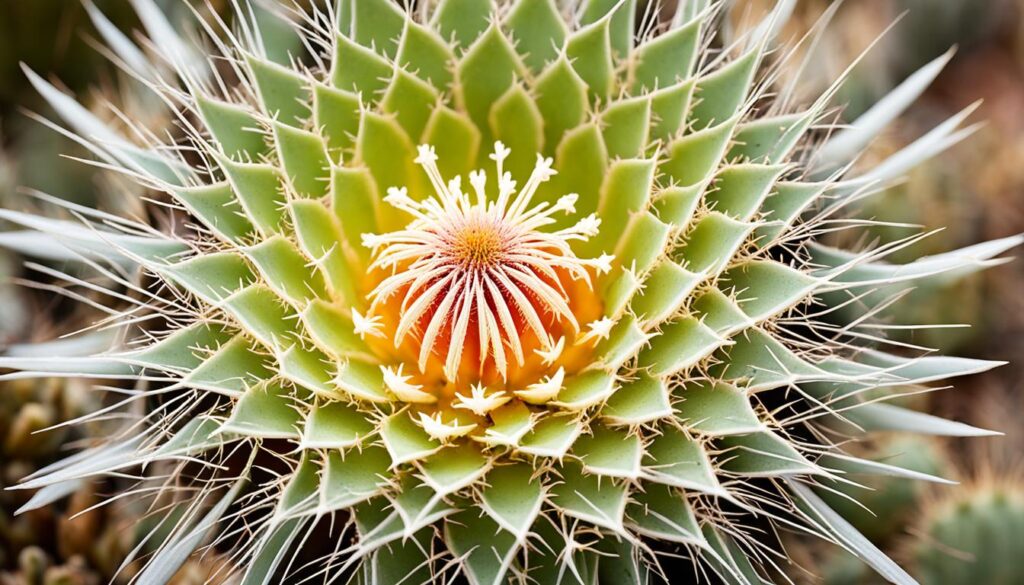
Cactus flowers, whether they bloom at night or during the day, have a unique way of surviving. Their short lives are a sign of their strength and smart ways to live in tough places.
Cacti and Pollinators: A Symbiotic Relationship
Cactus blooms are a key food source for bees, butterflies, birds, and bats. This relationship is crucial for both the cacti and the pollinators. It shows how life is connected in nature.
Bats and cacti have a special bond. The Lesser Long-Nosed Bat and Mexican Long-Tongued Bat fly from Mexico to places like Arizona and Texas. They help pollinate cacti in the southwestern U.S. These bats are endangered, showing how vital they are.
In places like Africa, Southwest Asia, and the Pacific Islands, bats pollinate plants at night. They fly far to spread pollen, helping plants grow and diversify. Unlike daytime pollinators, bats work at night, helping plants that bloom then.
The link between bats and cacti is key to pollination and ecosystem health in the southwestern U.S. For example, the saguaro cactus needs the Lesser Long-Nosed Bat to pollinate it. The bats travel up to 30 miles to spread the cactus seeds.
But this balance is at risk. Climate change, invasive species, and extreme weather can mess with the timing of cactus blooms and pollinators. Keeping cactus pollinators healthy is vital for these desert plants to survive.
| Key Cactus Pollinators | Ecological Role | Conservation Status |
|---|---|---|
| Lesser Long-Nosed Bat | Pollinate saguaro cacti in the southwestern U.S. | Endangered |
| Mexican Long-Tongued Bat | Pollinate cacti in the southwestern U.S. | Endangered |
| Bees, Butterflies, Birds | Pollinate a variety of cactus species | Varies |
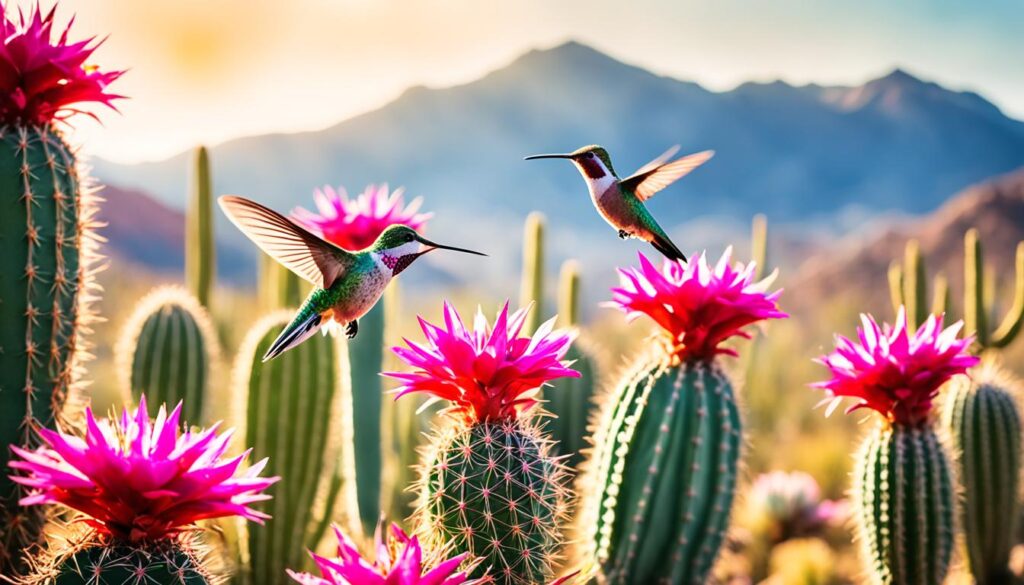
Learning about the bond between cacti and their pollinators helps us protect these ecosystems. This way, we can help these desert plants thrive.
Appreciating Nature’s Artistry
Cactus flowers are more than just pretty. They show how tough and flexible these plants are. By learning about what makes them bloom, you can enjoy nature’s art up close. They bloom in the day and at night, reminding us of the beauty around us.
The prickly pear cactus has bright pink and yellow flowers. The Black Knight cactus has regal magenta ones. Each flower is a unique work of art. Artists like Frida Kahlo and writers like Gabriel Garcia Marquez see them as symbols of strength and beauty.
To see cactus flowers as art, you need to know how to care for them. Give them the right light, temperature, and water. This way, you can enjoy their beautiful blooms. Seeing these flowers lets you appreciate their growth and strength, like in Georgia O’Keeffe’s art.



